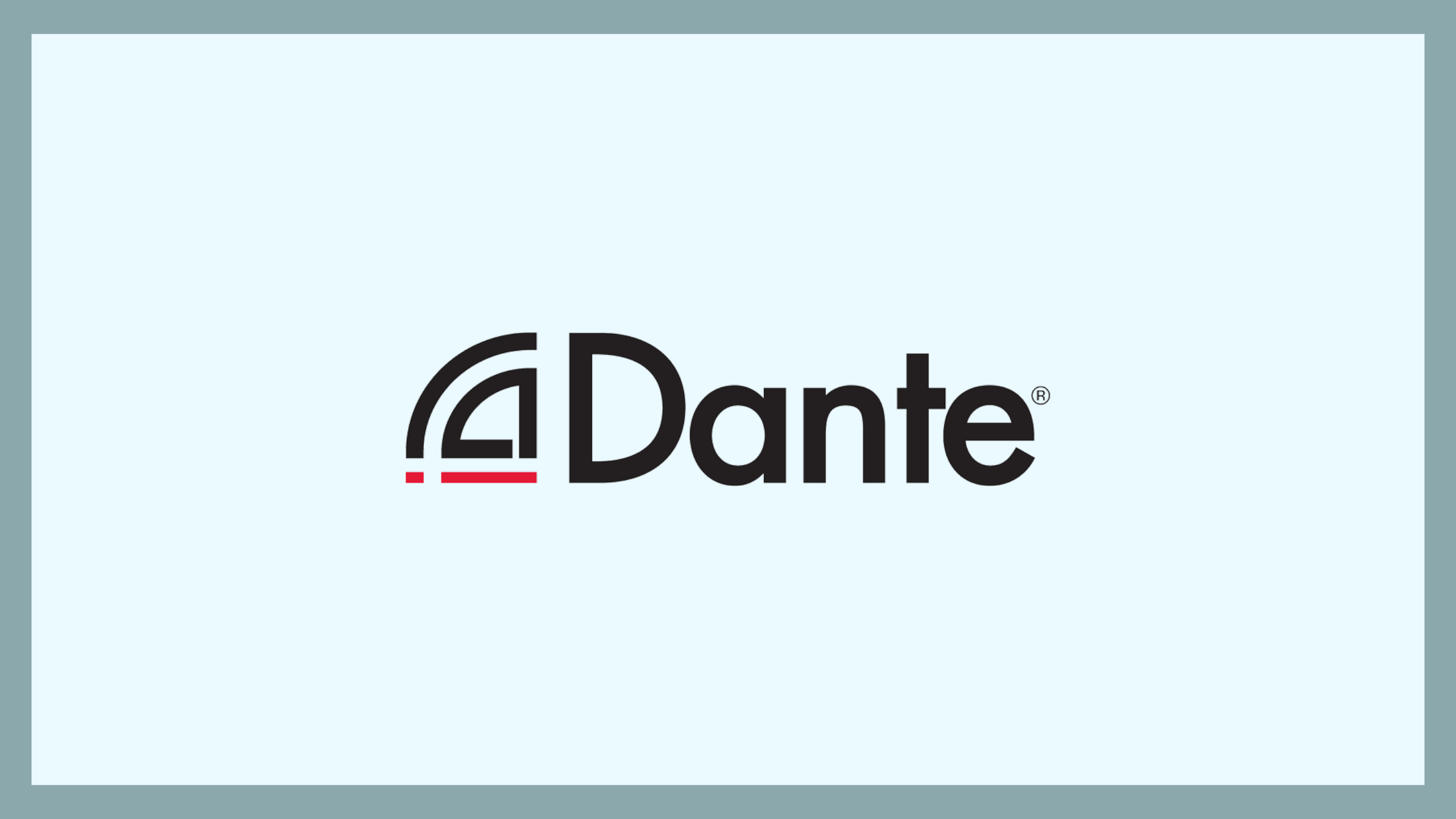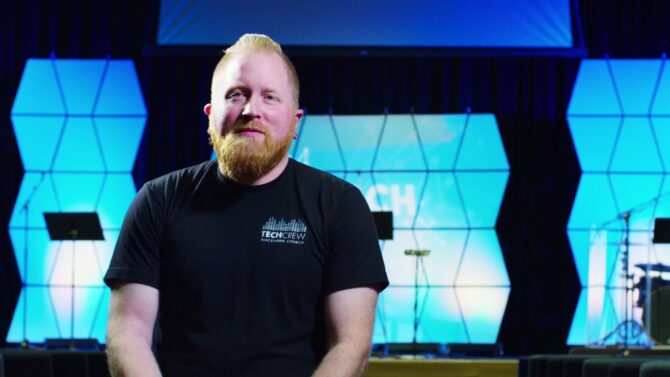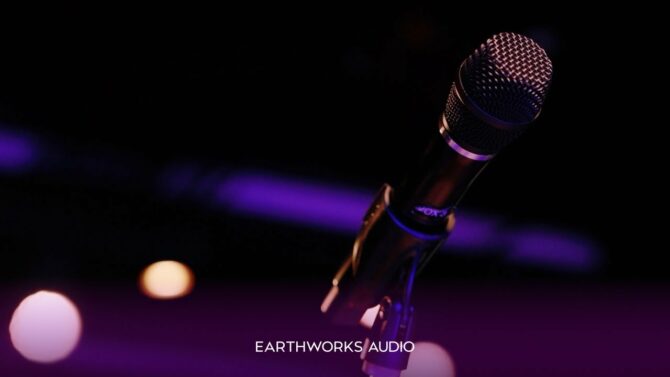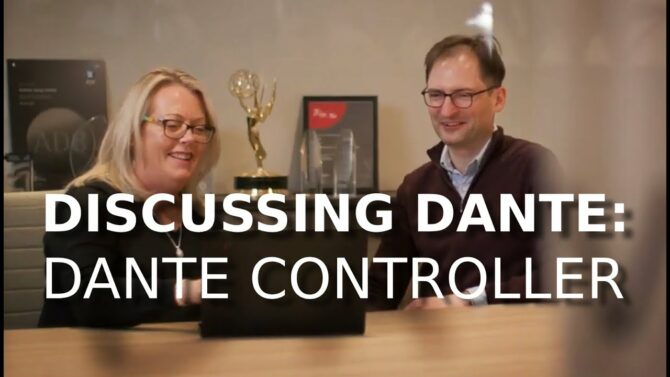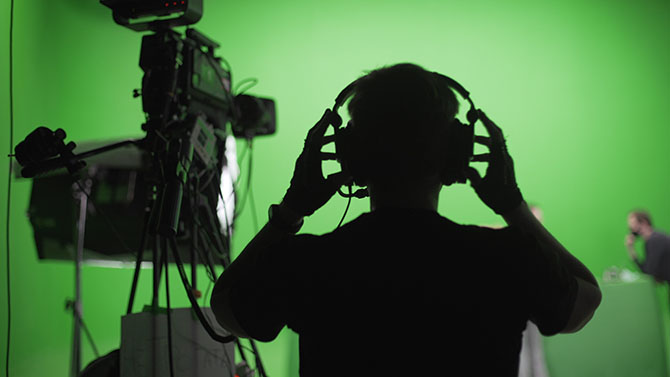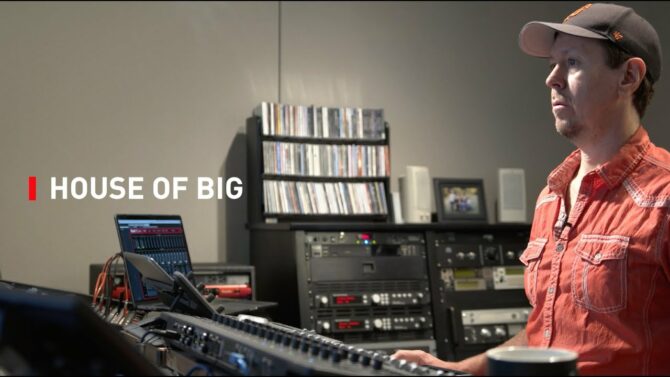Transferring audio over long distances, especially with multiple channels, has always been a challenge. Thick wire snakes were one option, but they’re expensive—and in the analog Definition:
Definition:
A signal that is continuous in nature, as opposed to being defined as a series of discrete numbers (or elements) as found in digital signals; electrically "analogous" to an acoustical signal in the air. world, audio quality deteriorates rapidly with distance.
Just as digital Definition:
Definition:
A signal or data expressed as series of the digits 0 and 1, typically represented by values of a physical quantity such as voltage or magnetic polarization. technology has changed all aspects of audio, it has largely solved the problem of transferring audio in near real-time. Although there are several digital audio transfer protocols, Dante Definition:
Definition:
Dante™ (Digital Audio Network Through Ethernet): The audio-over-IP standard created by Audinate (layer 3). (Digital Audio Network Through Ethernet Definition:
Definition:
A local area network (LAN) using cables classified according to certain categories (CAT5, CAT6, CAT5e, etc.). These relate to the speed a cable can handle.) is a common, proven protocol that improves on older options, like EtherSound and CobraNet Definition:
Definition:
Peak Audio's network standard for transmitting audio, video and control signals..
With smaller installations, like project studios, Thunderbolt Definition:
Definition:
A computer interface port or cable that multiplexes PCIe and DisplayPort data lines into two serial signals (along with DC power), which is then demultiplexed into separate PCIe and DisplayPort ports by the Thunderbolt controllers at receiving devices. and USB Definition:
Definition:
(Universal Serial Bus) A standard, bi-directional serial connection between computers and peripheral devices. usually provide any needed connectivity. Dante is most relevant with medium-to-large or complex commercial installations, such as live performance for touring bands, houses of worship, stadiums, hotel meeting rooms, and the like. Also note that Dante isn’t just about transferring multiple channels of audio to one location, but sending audio to multiple locations. However, even home studios are getting into Dante networking—consider a situation where the control room is on the second floor, but the place to mic drums is in the garage. Dante is a simple solution for getting audio from one place to another, without degradation.
Into the Ether(net)
Dante, developed by Australian company Audinate, works over standard IT networks—Fast or Gigabit Ethernet (nominal 100 Mbits/second or 1 Gigabits/second data Definition:
Definition:
Information used by a computer in order to arrive at a decision. Although this is a plural term, it's often treated in the singular. rates, respectively). Signals are multiplexed over CAT5e (or CAT5 for 100 Mbps-only networks), CAT6, or fiber-optic cables, so you don’t need thick snakes any more. The protocol also features synchronization and low latency Definition:
Definition:
The amount of delay a signal, data, sound, video, or control signal acquires within a device, system, or long-distance connection..
Because the system is Ethernet-based, setup will be familiar to anyone who’s used Ethernet. The same principles of setting up a home network for internet access apply here—to set up a Dante network, you plug Definition:
Definition:
A connector, normally male and attached to a cable. devices into an Ethernet switch, connect a MacOS or Windows computer to the network, and use the Dante Controller Definition:
Definition:
1. A MIDI device (keyboard, guitar with appropriate interface, etc.) that alters parameters in a synthesizer or other MIDI sound generator. 2. A device (e.g., modulation wheel, pitch bender, ribbon controller, etc.) that varies some specific parameter in a synthesizer or other MIDI sound generator. application to discover, display, and route devices. Also note that Dante can use your computer as an audio interface Definition:
Definition:
A device to convert audio signals into digital code suitable for use by a computer; typically communication occurs through a port such as USB, Thunderbolt, FireWire, etc. , which makes it easy to integrate virtual studio software (like Pro Tools, Nuendo, Studio One, Digital Performer, Samplitude, etc.) with the Dante system. This also means that for applications like restaurants and hotels, you can pipe music or presentations from a computer into a wide-ranging system.
The Software: Where It Starts
Dante starts with software. Audinate’s Dante Controller (Fig. 1) is a free, cross-platform download Definition:
Definition:
To receive data at one computer from another source (computer, electronic mail service, the cloud, etc.) from the Audinate site for setting up a Dante system.
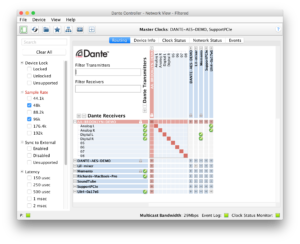
The software provides configuring, a routing matrix Definition:
Definition:
1. (mixers) A crosspoint of controls for creating different mixes simultaneously. 2.(video) A crosspoint for switching a number of video input signals to different outputs. Also called Audio Follow Video Matrix., automatic device discovery, device locking and unlocking, “friendly name” device renaming, wi-fi Definition:
Definition:
A wireless network protocol for device networking and internet access. Also spelled WiFi, wifi, or Wifi. support, and more, as well as diagnostics (e.g., bandwidth Definition:
Definition:
A range of frequencies that a device can generate, reproduce, or process. This usually implies little or no alteration within the range. usage, latency and clock stability statistics, event logging, and the like). You can store presets for later recall.
There are also inexpensive accessory programs, like Dante Virtual Soundcard for interfacing with your computer and DAW Definition:
Definition:
DAW (Digital Audio Workstation): A computer program or stand-alone device that provides digital audio recording, editing, and mixing., and Dante Via for network connectivity with USB and FireWire Definition:
Definition:
Apple protocol (also IEEE-1394), developed with other companies including Sony and Panasonic, for digital data transfer at rates of 100-800 Mbps devices (with multi-channel Definition:
Definition:
1. In radio, television, citizen's band radio, and other wireless communications modes, a specific frequency for communication. 2. In mixers and video, an input or output signal path with controls. 3. In MIDI, one of 16 data paths. audio routing—even send different audio to different applications). Dante Domain Manager is a higher-ticket item that falls more into the world of IT professionals, and provides functions like encrypted control traffic, backup Definition:
Definition:
1. (verb) To create a copy of existing software to insure against loss of the original. 2. (noun) The copy of the original software. and restore, and alerts.
Retrofit Cards and Adapters for Existing Gear
With Dante, you don’t need to blow your budget and buy all-new hardware. There are adapters available for various types of analog and digital connections, and many existing products can be retrofitted with a Dante hardware card. There are also Dante adapters that interface individual connections or pieces of gear to a Dante network.
However, for many, the most elegant solution is a system that includes all the elements needed for a variety of Dante-related systems. For example, what you need to shuttle files among several studios working with Pro Tools on a movie soundtrack is going to be different from distributing audio throughout an airport. Focusrite’s RedNet is probably the best-known system for high-quality audio installations; pairing Audinate’s Dante protocol with Focusrite’s audio hardware and networking expertise accommodates pretty much any Dante-related audio application. (Please see the related article Focusrite RedNet: The Audio-over-IP Ecosystem for more information.)
Why Dante?
Dante isn’t the only networking option that uses Ethernet; there’s also AVB Definition:
Definition:
AVB (Audio Video Bridging): A network standard by the Avnu Alliance. (Audio Video Bridging). Yet even though AVB is an open standard, Dante—despite being a proprietary standard that requires licensing—has gotten more traction. With so many manufacturers signing on to Dante, there’s a wide range of compatible Definition:
Definition:
Capable of operating with a particular selection of hardware or software. equipment. If you want something from company A to work with units from companies B – Z Definition:
Definition:
Symbol for impedance., the odds are that Dante will be able to take care of your needs.
There are many reasons for the popularity of today’s digital networking options. Of course, one is the universality of digital audio, which engenders a growing need to distribute it. Another is that building networks on Ethernet, which is reliable, common, and familiar (you don’t have to be an IT professional to use Dante, or even to get a system up and running for basic applications), means there’s enough bandwidth to handle multi-channel, uncompressed audio.
Furthermore, Dante uses an Ethernet star connection topology, which is a more practical (and lower latency) way to deliver digital audio than networks based on daisy-chaining. The ability to integrate existing gear is also important, because it means you can start with Dante and over time, convert to a from-the-ground-up, Dante-based system such as RedNet. Besides, who isn’t thrilled with the idea of replacing expensive, bulky snakes with slender CAT5e and CAT6 cables?
The bottom line is that Dante is here to stay, and much of that is because of the support it has received in the audio industry. This support will only increase in the years ahead.



